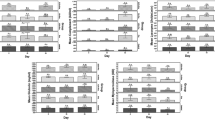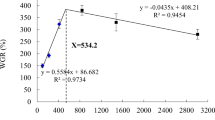Abstract
Teleost fish lack the enzyme for endogenous synthesis of ascorbic acid (AA), an essential micronutrient for fish. The aim of this study was to examine the effect of higher levels of dietary vitamin C on growth, nutritional quality, and immunomodulation in the Indian major carp, rohu (Labeo rohita). Four groups of L. rohita were fed experimental diets containing either no vitamin C (control) or supplemented with vitamin C at 500 mg kg−1 (Exp-1), 1000 mg kg−1 (Exp-2), or 1500 mg kg−1 (Exp-3) for 60 days. Growth parameters (NWG, ADG, and SGR), serological parameters (TSP, TSA, TSG, and A:G), haematological parameters (TLC, TEC, Hct, MCV, and MCH), and different non-specific immunological parameters (PR, PI, respiratory burst activity, and bactericidal activity) were evaluated during the experimental trial. Fish fed a vitamin C-supplemented diet showed higher specific growth rate (SGR) up to 1000 mg kg−1 compared with control fish. Different haematological and serological parameters along with non-specific immune parameters were influenced by vitamin C supplementation. Among the non-specific immune parameters phagocytic activity (PR and PI) and respiratory burst activity (NBT cells) were significantly (P ≤ 0.05) enhanced by increasing doses of vitamin C supplementation. Higher levels of dietary vitamin C significantly (P ≤ 0.05) enhanced protection against Aeromonas hydrophila (AH1) infection compared with controls. Results from this study help to establish the beneficial effect of vitamin C on growth and immunmodulation in rohu (L. rohita).



Similar content being viewed by others
References
Association of Officials Analytical Chemistry (AOAC) (1990) Official methods of analysis. In: Williams S (ed) 15th edn. AOAC, Virginia, 1298 pp
American Public Health Association (1998) Standard method for the examination of water and wastewater, 20th edn. APHA, Washington
Austin B, Stuckey LF, Robertson PAW, Effendi I, Griffith DRW (1995) A probiotic strain of Vibrio algilolyticus effective in reducing diseases caused by Aeromonas salmonicida, Vibrio anguillarum and Vibrio ordalii. J Fish Dis 18:93–96
Banerjee SK, Patra BC, Bandyopadhyay P, Tewary A (2002) Changes of the blood parameters in an Indian major carps, Catla catla Ham. due to Myxozoan parasites infection. Ind J Aquat Biol 17(1):79–84
Bandyopadhyay P, Swain SK, Mishra S (2005) Growth and dietary utilization in gold fish (Carrassius auratus Lin) fed diets formulated with various local agro-products. Bioresour Technol 96(6):731–740
Bazaz MM, Keshavanath P (1993) Effect of feeding levels of sardine oil on growth, muscle composition and digestive enzyme activities of mahseer, Tor khudree. Aquaculture 115:111–119
Bernfeld P (1955) In: Colowick SP, Kaplan NO (eds) Methods of enzymology, vol 1. Academic Press, New York, p 149
Blazer V (1982) The effect of marginal deficiency of ascorbic acid and alfa tocopherol on the natural resistance and immune response of rainbow trout (Oncorhynchus mykiss) immunity. Ph.D thesis, Univ. Microfilms Intern. USA 113
Bulow JF, Coburn CB, Cobb CS (1978) Comparison of two bluegill populations by means of the RNA-DNA ratios and liver-somatic index. Trans Amer Fish Soc 107:799–803
Chaterjee GC (1967) Effects of ascorbic acid deficiency in animals. In: Sebrell WH Jr, Harris RS (eds) The vitamin, vol 1. Academic press, New York, pp 407–456
Chen HY, Chang CF (1994) Quantification of vitamin C requirements for juvenile shrimp (Penaeus monodon) using phosphorylated L-ascorbic acid. J Nutr 124:2033–2038
Clemmesen CM (1987) Laboratory studies on RNA/DNA ratios of starved and fed herring (Clupea harengus) and turbot (Scopthalmus maximus) larvae. J du Conseli International de 1’ Exploration du Mer 43:122–128
Decie SIV, Lewis SM (1991) Practical haematology, (VII edn). Churchill, Livingston
Duncan DB (1955) Multiple range and multiple F-tests. Biometrics 11:1–42
Dupree HK (1966) Vitamins essential for growth of channel catfish. US Bureau of Sport Fisheries and Wild life technical Paper. No. 7
Durve VS, Lovell RT (1982) Vitamin C and disease resistance in channel catfish (Ictalurus punctatus). Can J Fish Aquat Sci 39:948–951
Halver JE, Ashley LM, Smith RE (1969) Ascorbic acid requirements of coho salmon and rainbow trout. Trans Amer Fish Soc 98:762–722
Hardie LJ, Fletcher TC, Secombes CJ (1991) The effect of dietary vitamin (on the immune response of the Atlantic salmon (Salmo salar L.). Aquaculture 95:201–214
Jaffre GM (1984) Vitamin C. In: Machlin LJ (ed) Hand book of vitamins. Marcel Dekker, New York, pp 199–244
Kaneko S (1971) Microbiological study of fresh fish (2). New Book Indus 13(7):76–80
Keshavanath P, Renuka P (1998) Effect of dietary L-carnitine supplements on growth and body composition of fingerling rohu. Labeo rohita (Ham). Aquat Nutr 4:83–87
Kulow H (1967) Eine Schnellmethode zur Bestimmung der Serumproteine von Satzkarpfen (A rapid method of finding the serum proteins in young common carp). Dt Fischerei-Ztg 14:241–149
Lall SP, Oliver G (1993) Role of micro nutrients in immune response and disease resistance in fish. Fish Nutr Prac 61:101–118
Landolt M (1989) The relationship between diet and the immune response of fish. Aquaculture 79:193–206
Leano ME, Ju Guo J, Chang SL, Liao CI (2003) Levamisole enchances non-specific immune response of cobia, Rachycentron canadum, fingerlings. J Fish Soc Taiwan 30(4):321–330
Lovell RT (1973) Essentiality of vitamin C in feeds for intensively fed caged channel catfish. J Nutr 103:134–138
Mazik PM, Brandt TM, Tomasso JR (1987) Effects of dietary vitamin C on growth, caudal fin development and tolerance of aquaculture related stressors in channel catfish. Prog Fish Cult 49:13–16
Miglavs I, Jobling M (1989) Effects of feeding regime on food consumption, growth rates and tissue nucleic acids in juvenile arctic charr, Salvelinus alpinus, with particular respect to compensatory growth. J Fish Biol 34:947–957
Mitra G, Mukhopadhyay PK (2002) Growth, nutrient utilisation and tissue biochemical changes in Labeo rohita, fed with natural and prepared diet. J Appl Aqua 12(3):65–80
Mitra G, Mukhopadhyay PK (2003) Dietary essentiality of ascorbic acid in rohu larvae: quantification with ascorbic acid enriched zooplankton. Aqua Intern 11:81–93
Mulero V, Esteban MA, Munoz J, Meseguer J (1998) Dietary intake of levamisole enhances the immune response and disease resistance of the marine teleosts gilthead seabream (Sparus aurata L.). Fish Shellfish Immunol 8:49–62
Munro HN, Fleck A (1969) Analysis of tissue and body fluids for nitrogen constituent in mammalian protein metabolism. In: Munro HN (ed), Academic Press, New York, pp 433–525
Navarre O, Halver JE (1989) Disease resistance and humoral antibody production in rainbow trout fed high levels of vitamin C. Aquaculture 79:207–221
Patra BC, Maity J, Debnath J, Patra S (2002) Making aquatic weed useful II: Nymphoides cristatum (Roxb.) O. Kuntze as fish feed for an Indian major carp Labeo rohita (Ham). Aqua Nutr 8(1):33–42
Park JH, Jeong HD (1996) Enhanced resistance against Edwardsiella tarda infection in tilapia (Oreochromis niloticus) by administration of protein bound polysaccharide. Aquaculture 143:135–143
Roberts ML, Davies SJ, Pulsford AL (1995) The influence of ascorbic acid (vitamin C) on non-specific immunity of trout (Scopthalmus maximus). Fish Shellfish Immunol 3:179–190
Rougier F, Troutaud D, Ndoye A, Deschaux P (1994) Non-specific immune response of Zebra fish, Brachydanio rerio (Hamilton–Buchanan) following copper and zinc exposure. Fish Shellfish Immunol 4:115–127
Sahoo PK, Mohanty J, Mukherjee SC (1999) The effect of three immunomodulators on haematological parameters and immunity level in rohu (Labeo rohita) fingerlings. J Aquac Trop 14:127–135
Sahoo PK, Mukherjee SC (2003) Immunomodulation by dietary vitamin C in healthy and alphatoxin B1-induced immunocompromised rohu (Labeo rohita). Comp Immunol Microbiol Infect Dis 26:65–76
SAS (1991) SAS Institute Inc. SASR system for regression, 2nd edn. SAS Institute Inc, Cary, p 210
Siwicki AK, Anderson DP, Rumsey GL (1994) Dietary intake of immuno stimulants by rainbow trout affects non-specific immunity and protection against furunculosis. Vet Immunol Immunopathol 41:125–139
Shiau SY, Jans FI (1992) Dietary ascorbic acid requirement of juvenile tilapia Oreochromis niloticus × O. aureus. Nippon Suisan Gakkaishi 58(4):671–675
Thompson I, White A, Fletcher TC, Houlihan DF, Secombes CJ, (1993) The effect of stress on the immune response of Atlantic salmon (Salmo salar L.) fed diets containing different amount of vitamin C. Aquaculture 114:1–18
Waagbo R, Glette J, Nilsen ER, Sandnes K (1993) Dietary vitamin C, immunity and disease resistance in Atlantic salmon (Salmo salar). J Fish Physiol Biochem 12:61–73
Waagbo R (1994) The impact of nutritional factors on the immune system in Atlantic salmon. Salmo salar L: a review. Aquac Fish Manag 25:175–197
Wahli T, Verlhac V, Gabuadan J, Meire W, Schuep W (1998) Influences of combined vitamin C and E on immunity and disease resistance of rain bow trout (Oncorhynchus mykiss). J of Fish Disease 21:127–137
Wintrobe MM (1978) Clinical haematology. In: Kipton H (ed), London, pp 85–89
Verlhac V, N’Doye A, Gabaudan J, Troutaud D, Deschaux P (1993) Vitamin nutrition and fish immunity; influence of antioxidant vitamins (C and E) on immune response of rainbow trout (Oncorhynchus mykiss). In: INRA (ed) Fish nutrition in practice. pp 167–177
Verlhac V, Gabaudan J (1994) Influence of vitamin C on the immune system of salmonids. Aquac Fish Manag 25:21–36
Acknowledgement
The authors are thankful to the Department of Science and Technology, government of West Bengal, for providing infrastructure facilities. The authors are also thankful to the Department of Zoology for extending all sorts of working facilities and the Research Scholars of the Aquaculture Research Unit, Department of Zoology, Vidyasagar University, for their valuable co-operation in the preparation of this manuscript.
Author information
Authors and Affiliations
Corresponding author
Rights and permissions
About this article
Cite this article
Tewary, A., Patra, B.C. Use of vitamin C as an immunostimulant. Effect on growth, nutritional quality, and immune response of Labeo rohita (Ham.). Fish Physiol Biochem 34, 251–259 (2008). https://doi.org/10.1007/s10695-007-9184-z
Received:
Accepted:
Published:
Issue Date:
DOI: https://doi.org/10.1007/s10695-007-9184-z




